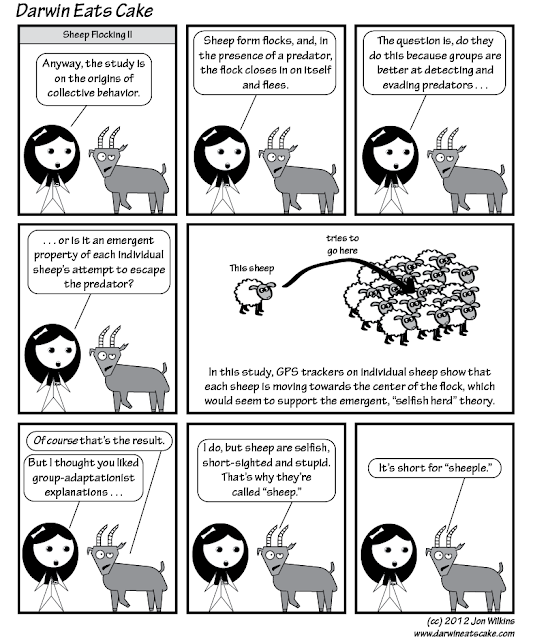So, as you are well aware, a couple of days ago, human-shaped pile of garbage Todd Akin articulated his belief that “legitimate rape” rarely leads to pregnancy, due to the magical uterine “shutting that whole thing down” properties of the uterus. Here at Lost in Transcription, we discussed the fact that there are some species that do, in fact, exhibit the capacity for “post-copulatory female choice.” However, humans are not one of these species, unless you count the set of medical interventions that Akin is trying to outlaw (along with Romney, Ryan, and the official Republican party platform).
If you’re interested, Kate Clancy wrote up an excellent summary of the actual science on the topic of pregnancy and rape.
Jesse Bering (an evolutionary psychologist who has been featured on this blog previously) also weighed in on the science, using twitter to point to an article that had recently written on “Darwin’s Morning After Pill.” In the article, Bering outlines an argument for the adaptive value of preeclampsia. The argument features “seminal priming theory,” which Bering calls “criminally unread,” and which has been promoted by Gordon Gallup (who, like a certain goat I know, has an adaptationist story for just about everything).
Roughly, the argument is this. Women don’t want to let a man get them pregnant unless they are certain that the man is going to stick around for the long haul. So, you want to have a biological mechanism that prevents pregnancy from one-night stands, but encourages pregnancy when you are in a committed relationship. Preeclampsia is a convenient (if life threatening) way for mother nature to terminate your pregnancy when it would be better not to have a baby. Therefore, preeclampsia should be more common for pregnancies resulting from sex with an unfamiliar male. Preeclampsia should be less common when it is the product of a long-term sexual relationship.
The proposed mechanism is that exposure to a male’s semen sort of habituates the female to the biochemistry of that particular male. Preeclampsia is associated with certain inflammatory features that share some similarities with an immune response. In that sense, preeclampsia is sometimes thought of as the mother rejecting the foreign body of the fetus, sort of like how one might reject a transplanted organ. The idea, then, is that through exposure to the male’s semen, the female ratchets down this response, thereby allowing the pregnancy to move forward.
 |
| One way of thinking about preeclampsia is as the rejection of an alien body by the mother |
Jeremy Yoder has written a nice piece detailing how, even if we accept all of this, it is ridiculous to think of this mechanism as an adaptation. In particular, even under the most generous set of assumptions, natural selection acting on such a mechanism would be vanishingly small. And, of course, even to get there, you have to buy the typical evolutionary psychology assumption of an “environment of evolutionary adaptation” that looks an awful lot like the normative middle-class, suburban values of 1950s television America.
There are a few lines of evidence that are cited (by Bering, and in general) in support of the idea. The bulk of the evidence hinges on the observation that changing partners increases a woman’s probability of preeclampsia. For example, if your second pregnancy has the same father as your first pregnancy, you are less likely to develop preeclampsia than if the two pregnancies have different fathers. This is a finding that has been replicated a number of times, and with very large samples, so that’s pretty solid, right?
Actually, no. While the association between paternity switch and preeclampsia is true, it probably doesn’t mean what Bering and Gallup think it means, and the relevant data doesn’t actually support the seminal priming theory.
The problem is that a change in paternity correlates with time between pregnancies. So, if your two kids have different fathers, it is more likely that the two pregnancies were spaced farther apart. My reading of the literature is this: in every case where there is an association between paternity switching and preeclampsia, the study has not separately controlled for time between pregnancies. In each study where time between pregnancy is explicitly controlled for, the association with paternity switching vanishes. (See, e.g., this or this.)
In fact, controlling for time between pregnancies, if you have preeclampsia in your first pregnancy, switching partners actually makes you less likely to have preeclampsia in your second one. Don’t get too excited though. The converse is also true. If you don’t get preeclampsia in one pregnancy, switching partners makes you more likely to get it in the next one.
What that suggests (to me, anyway), is that some fathers are more likely to produce preeclampsia than others (or, alternatively, that the probability of preeclampsia depends on some interaction between the maternal and paternal genotypes). According to this explanation, if you don’t get preeclampsia, it means that you and your partner are at low risk. If you switch partners, though, you go back into the standard risk pool. (This interpretation is also consistent with this study, which followed fathers.)
There are a few other lines of evidence, which are cleaner in their implications. One study on artificial insemination finds preeclampsia more often in cases where the woman was inseminated with a stranger’s sperm than in cases where she was inseminated with her partner’s. There is also a study that finds that frequent oral sex correlates with a reduced risk of preeclampsia. (That’s her performing oral sex on him, not the other way round.) Does the frequency of oral sex correlate with the spacing between kids? I don’t know. I’m hoping that some of you will weigh in on that in the comments.
 |
| Males ingesting female gametes also has well documented health benefits. |
The problem with these studies is that, unlike the partner-switching studies, we’re looking at small numbers. Whether or not they will hold up under more extensive analysis it not yet clear.
My read on the whole thing? At the moment, the data just isn’t there. All that exists in support of the seminal priming theory is an adaptationist fairy tale and a couple of small studies that have yet to be reproduced.
Oh, and also a whole bunch of studies that, if you cherry pick from among them, and ignore all of the studies that contradict them, support the theory. Of course, that’s pretty much true of any theory, which is exactly why evolutionary psychology continues to be such a booming field.











